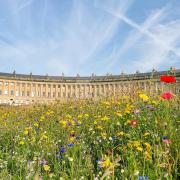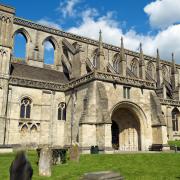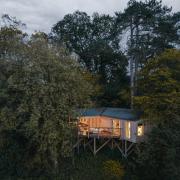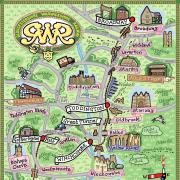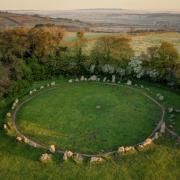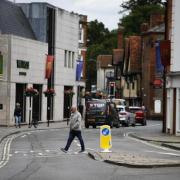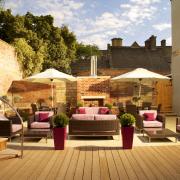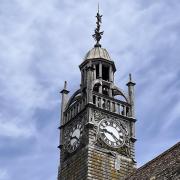The Oxfordshire market town where resident ‘Wombles’ keep busy with creativity, recycling, and make-do-and-mend.
Some 50 years ago, I, like many children of the 1970s, were introduced to a group of pointy-nosed furry creatures who collected and creatively recycled rubbish in their burrows on a common in Wimbledon. These loveable fictional characters, known as The Wombles, had a motto. It was relevant then; it is relevant today. As their famous signature tune states: ‘making good use of the things that we find, things that the everyday folk leave behind.’
Womble creator, author Elizabeth Beresford, apparently based one of the main characters, Orinoco on her teenage son. Although at times lazy, this adorable Womble was a well-meaning resourceful fellow who showed moral and physical courage.
Metaphorically, this Womble is very active in Banbury, an historic market town in North Oxfordshire, although there is nothing lazy about this one. Turn back the pages of its history and one discovers the town has always been good at recycling. Many of the buildings of the town were built with the bricks from its former castle.



After the Civil War, the townspeople petitioned Parliament for the right to demolish the castle remains and use the stone to rebuild Banbury. Much of the building stone used in the town is local ironstone, but if you spot a red stone, it may be from a fire-damaged part of the castle. A couple of years ago, my husband and I went in search of these special red stones. Under the guidance of Dale Johnston, exhibitions manager of Banbury Museum & Gallery, we became history detectives to find evidence of the town’s Civil War past.
So, remnants of recycled castle are hidden within the brickwork of Banbury, a very Womble thing to have done. Today’s Banbury has its own Orinoco. It is the name of the town’s brilliant scrapstore at 57-58 High Street, run by an amazing warm-hearted team of human Wombles, who not only collect unwanted treasures and scrap materials, but encourage young and old to reuse them in fun ways by organising many workshops, sharing skills, and building intergenerational relationships.

Run by manager Lisa Hawtin, Orinoco is such a positive place to visit.
‘The company set up about 30 years ago in Oxford,’ she says, ‘and we have had one here in Banbury since Covid. Our mission statement is to ‘banish boredom and save the planet using creativity and play to inspire the reuse of materials.’
People come in and buy scrap in the form of old lampshades, gadgets, materials, toys, and items which can be used for craft, play and creative projects. Each recycled item is weighed when bought so the team can monitor how much waste has been saved from landfill.

‘Since October, we have saved 26 tonnes of waste,’ says Lisa. By the time you read this, it will be a lot higher.
‘Orinoco is a hub. It represents a whole range of skills and expertise, such as book-folding, lacemaking and sewing. This week, we have had a Brownie, Rainbow, and Scout group in making crafts with scrap materials,’ explains Emma Brion Giles, outreach co-ordinator.
‘I had an art lesson with a 10-year-old this morning. When you see an 85-year-old talking to a 16-year-old and watching them teach each other, it’s wonderful.’
It is not just the community which benefits. The volunteers say they love being part of such an encouraging place.
‘Everybody here is happy; if you are feeling low, they cheer you up and keep you busy. Everyone mucks in and looks after one another,’ says volunteer Sue Cameron. ‘We have many ladies on their own who come in and see us. We may be the only people they talk to, and they can have a tea and coffee, and there are always cakes and biscuits.’

Whilst on the subject of hot drinks, The Coffee Guys is a mobile coffee business run by brothers-in-law Chris Chandler and Kenny Gillett. Parked up in the market square, I notice they sell the town’s famous Banbury cake, which is a spiced, oval-shaped, currant-filled pastry, so I stop to chat to Chris.
‘It’s my hometown,’ he says. ‘It’s a small market town and, having run a shop for 16 years, I decided to set up business with my brother-in-law. We both love quality fresh ground coffee, and we also appear at weddings and festivals, where we can serve cocktails, wines, and spirits.’
‘We are in the market every Saturday – something we enjoy – although it can be a bit trying in the very cold, like today, but people are more likely to come looking for a hot drink.’
It was in Parsons Street where the first Banbury cakes were made by Edward Welchman in his bakery at number 12, from the early 1600s. The building was demolished in 1968. These flat, oval-shaped pastries filled with spiced currants, rosewater and rum – and a closely-guarded secret ingredient – became famous in the 1700s and were exported to Australia, India and America.

On today’s trip I visit number 21 Parsons Street, home to The Artery, an art shop owned by Barry Whitehouse, an inspiring individual who is passionate about encouraging others to tap into their own artistic potential.
Look up on the overhead beams, and inspiring quotes greet you from famous artists. ‘I dream my painting and I paint my dream,’ says Vincent Van Gogh, whilst Frank Zappa reminds us ‘art is making something out of nothing and selling it.’
Whatever the motive or reason for choosing creativity, it does unite all ages and does them good.
‘Art can be very solitary, and often we find with our classes it brings people together. I host 40 art classes every month, which cover all techniques and mediums, such as watercolour, acrylics, art history, oils, drawing, calligraphy, and gouache. People come from all over. During lockdown, I did the classes online, and we still have a regular student who joins in from the Lake District,’ he adds.
I am intrigued by his business name, The Artery.
‘I chose it because art is in my blood and we are in the heart of Banbury town centre, and the only independent art shop for miles around,’ explains Barry, who pays tribute to the town’s historic heritage.
‘Banbury has been a creative hub for such a long time. You only have to look at the wonderful architecture of the old buildings, and we have so much going on within the community, such as The Mill Art Centre.’

Barry is also a vintage singer, specialising in songs from the 1930s and 1950s and performs under the name of Beau Norton.
‘I love the fact that art and singing can reach people on a special level, and we often don’t realise the importance of art, music, memory, and creative projects. It’s wonderful to be able to do both and reach so many people,’ he adds.
A few years ago, Barry was asked to set up a pop-up gallery for local artists. It was supposed to be a month, but a month extended to three months, and then a permanent gallery which became so successful it became an artistic co-operative. Today, whilst Barry is no longer in charge, he is proud of what Church Lane Gallery has become. It is a delightful showcase for around 20 local artists who specialise in different disciplines, whether that is pottery, glass, millinery, painting, or pencil drawing.

I interrupt landscape artist Paul Coleman as he works.
‘It’s very important in the fact that people can show what they do,’ he says. ‘You don’t have to be a professional artist. I joined five years ago, and it was the first time I had ever showed my work. It gave me the opportunity to do that.’
Another showcase is Banbury Museum & Gallery, a family-friendly museum at the heart of Banbury’s vibrant canalside. Inside the shop are beautiful displays of handmade gifts, from glass pendants, to stunning scarves, paintings and homeware, all created by local artists.

The Pye Gallery, which is part of the museum, features an ever-changing programme of temporary exhibitions, whilst the museum itself pays tribute to the town’s origin and history with displays on the Civil War, plush manufacturing, the Victorian market town, and costume from the 17th century to the present day. The museum’s Pye Gallery will soon be hosting the 2024 Ironstone Art Prize exhibition, the best of artwork entered into open competition by artists living or working within a 25-mile radius of Banbury. The Artery is supporting the growth of the young artists in the area by sponsoring the Under 21 prize. The work selected by the judges will go on display from 27 January to 10 March 2024.
On the way to visit the plush display of rich, coloured fabrics Banbury once made in the heyday of its woollen industry success, I can’t resist jumping on a hobbyhorse to re-enact the nursery rhyme, ‘To ride a cockhorse to Banbury Cross…’ the town is famous for. I am not quite the fine lady, but I often create music. As visitors enter the town centre, they are greeted with an impressive statue of the fine lady in question on her cockhorse at Banbury Cross.



Music and textiles are important aspects of Banbury’s past, but also present. As mentioned, there is a lot of unseen good – or wombling – that goes on in Banbury, and it has a very strong connection with the arts and the community’s creative spirit.
As we drive over from Stroud to Banbury, it is a very cold winter’s day. Frozen spiders’ webs display artistry that is usually almost invisible unless one looks closely. Spiders are always at work, but it is only in sub-zero temperatures that their delicate masterful work is fully appreciated. I capture a few on camera on the canal lock near Banbury Museum and in holly bushes. What really catches my eye are the frozen webs which add an extra spectacle to a wire sculpture of two dancers outside The Mill Arts Centre.
The Mill is a tremendous place which exudes creativity. Its 237-seat professional theatre hosts world-class performances in drama, dance, music, and comedy, while its gallery and other studios play host to a thriving programme of creative workshops, classes and exhibitions. With a long and vibrant history, The Mill has transformed over the centuries from a working Victorian grain mill to a lively community centre, and later to the professional theatre and multi-artform venue it is today. As an Arts Council England National Portfolio Organisation, The Mill works with partner organisations across Oxfordshire and the UK to deliver community projects and initiatives both in and out of their building, serving as a hub for the arts in Banbury and beyond.


According to Emma Hiorns, creative director at The Mill, there’s plenty of highlights to look forward to in their 2024 programme:
‘Banbury has such a vibrant creative scene and we’re thrilled to be part of it! There are so many exciting things to see and do – whether it’s taking the family to see a show like the upcoming Shark in the Park inspired by Nick Sharratt’s beloved children’s books (February 10), joining in the fun with an energetic ceilidh (February 2), or an evening enjoying fantastic live music or comedy!’ says Emma.
‘We’re also delighted to offer more creative classes and workshops than ever before, with new classes in macramé, playwriting and sewing on offer in our spring term alongside our popular courses in visual art, jewellery making and much more.
‘This year we’re particularly excited to extend our creative offerings across Oxfordshire and beyond through our off-site programme of work Out of The Mill, where we work with partner organisations to host performances and workshops outside of our walls – ensuring that there really is something for everyone to enjoy,’ she adds.
Banbury BID is one of around 300 Business Improvement Districts across the country. Funded by local businesses, members of Banbury BID have been working hard in recent months to make Banbury more vibrant. Thanks to sponsorship from Chiltern Railways, the organisation has been able to work with the community on a vibrant mural at the former Robert Keith site. It was created by more than 70 local people, who took part in workshops hosted by The Mill, to celebrate what Banbury means to them.


Banbury BID strategist Jasmine Gilhooly has a background in textiles and set up her own business in 2012. Her art workshop was based on Parsons Street selling and making printed leather handbags which is how she got involved with Banbury BID.
‘I believe Banbury has such a wonderful talented pool of creatives. When I set up my business here, I met so many fellow artistic individuals and what I love is there is such a hub of creative entrepreneurs here,’ says Jasmine.
Another vibrant place which is full of life and colour is Banbury Sewing Centre on Parsons Street. One of my youngest daughters, Kezia (16) is an enthusiastic sewer and her eyes light up as we enter. She would spend hours looking at fabrics to inspire her next creation.

I recall making rag dolls, door hangers and tea cosies at a young age, and playing with my grandmother’s and my mum’s button tins. In my primary school, show-and-tell was not encouraged. But here in this wonderful store, every day is a show-and-tell, and those who work here just love looking at what members of the community are working on.
It is true many rekindled a love for making things and traditional skills, such as knitting, sewing, and painting were picked up with a passion during the lockdowns, but some put them aside as life resumed. However, many didn’t. And those inspired by the likes of the Great British Sewing Bee have dusted down their old sewing machines and have been inspired to make and create again.
Amy-Leigh Brennan-Rogers took over running the Banbury Sewing Centre when her mum, who ran the business for many years, died in January 2020. Amy expanded the business and took over its sister store in Witney in 2021.

Her staff are passionate and generous with their time and expertise, often sharing similar experiences with customers who want to knit a certain stitch or learn how to sew hems or attach zips. In Banbury, Tuesday evenings are dedicated to ‘knit and natter’ or a ‘crochet and chat.’
The day I visit, I chat with Jackie Scott, who loves knitting and crochet and is a source of encouragement to anyone who wants to learn or get better at their chosen craft.

‘We have young children in, as well as men who have knitted hats and scarves for presents,’ she says. ‘It is so good for wellbeing. We offer a lot of good advice here, it is not just about buying the items they need, we help them when they get stuck, and we love seeing what they have made.
‘We are always telling them to ‘show us your makes,’ because it is good to celebrate what we each can do.’
Celebration is what this feature on Banbury is about. I guess you could say it is my ‘show-and-tell’, informing readers about the hidden talents, the hidden warmth and care of the many Wombles of Banbury who are doing their best to make their town a better place for those who live and visit here.






